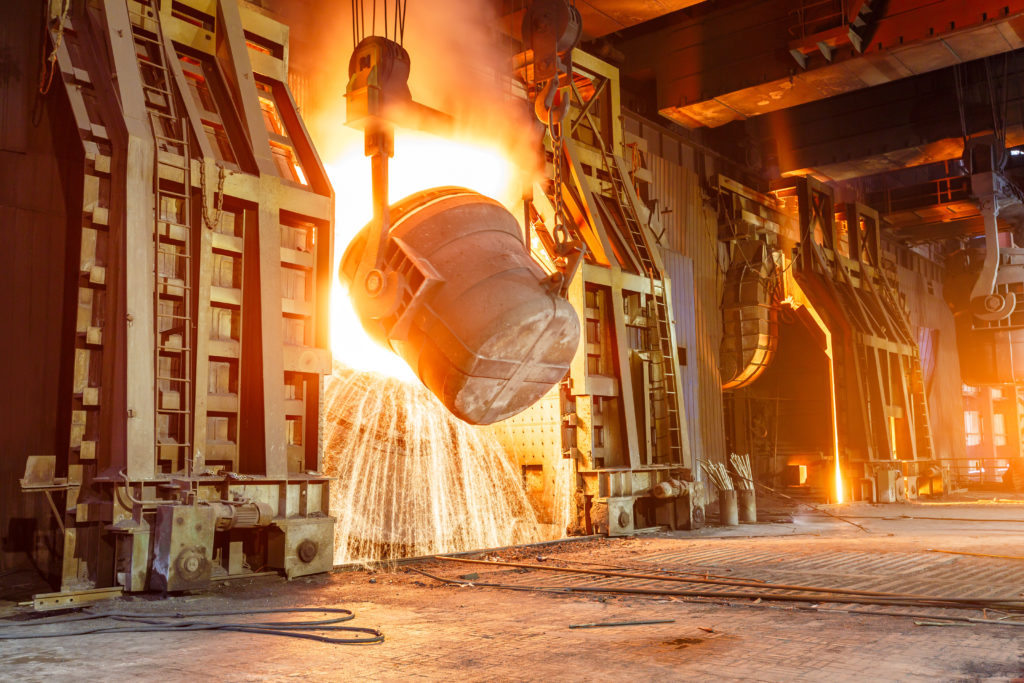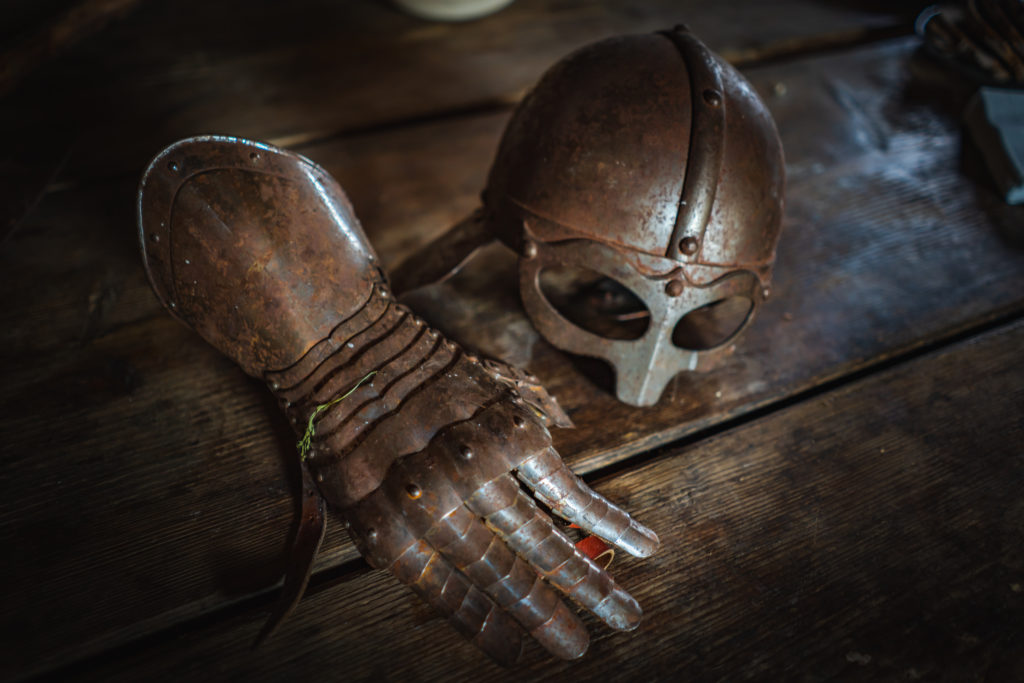The metals of antiquity — iron
Four of the beads in one grave were threaded onto a necklace with beads made from other precious materials, namely gold, carnelian, lapis lazuli, and agate. The other 3 beads in this particular grave were found at the waist of the body. The remaining 2 iron beads were located in another grave that also contained a wide variety of other beads made from calcite, carnelian, chalcedony, faience, garnet, gold, lapis lazuli, obsidian, serpentine and steatite.
The presence of other precious minerals with these iron beads appears to indicate that iron was ranked alongside them in terms of value, and that all these types of metals and materials were important symbols of wealth and status. It also seems that minerals in general were not originally sought out and used for utilitarian or functional purposes but rather “to serve as aesthetic visual displays of identity, whether of a social, cultural or ideological nature” (Roberts et al., 2009: 1019)2.
Just as significantly, the iron beads further indicate that metal workers knew about iron and how to work with it long before the dawn of the official Iron Age around 1,200 BC. In fact, there is growing evidence that iron was being used a lot earlier than originally thought3. Whilst much of it was the meteoric iron that had ‘arrived’ on earth in a native state that didn’t need smelting, there are records of sporadic terrestrial iron smelting occurring from the mid Bronze Age period (~2,200 BC – 1,570 BC) onwards.
The earliest evidence of smelted iron
Archaeological excavations at Kaman-Kalehöyük in Turkey unearthed some fragments of iron dating to around 2,200 – 2,000 BC. Subsequent archaeometallurgical analysis confirmed the presence of carbon, indicating the items were made from smelted terrestrial iron rather than meteoritic iron, which contains nickel. Therefore, it seems that in Central Anatolia at least metal workers knew how to smelt terrestrial iron as early as the late 3rd millennium BC and were producing a limited but steady supply of iron products, probably for a very select and elite market, throughout the early to late mid 2nd millennium BC.
This concept is supported by findings elsewhere around the pre-historic world. Tutankhamun for instance owned an iron sword made for him during the 14th century BC, a time when bronze still reigned supreme, especially for weapons, so he clearly had access to speciality iron products.

In India, ancient iron-working facilities in the Ganges Valley have been dated to 1,800 BC. There is also evidence that iron was being smelted and used to produce various artefacts across a wide area of the Eastern Vindhyas and Central Ganga Plain around the same time. Likewise, iron artefacts dating from the same period have turned up in Southeast and South Asia and the Middle East whilst in Africa some of the iron artefacts found there were made as early as 2,000 BC. A distinguishing feature of these items is the lack of nickel in the iron, indicating a terrestrial rather than meteoritic source.
Slightly more recently, the iron pillar of Delhi was built during the reign of Chandragupta II (375 – 415 AD) and has been studied for its noted corrosion-resistance qualities. India also has some famous iron cannons that are several centuries old.
Developing a process to turn iron ores into iron
Although smelting of other metals (copper, tin etc) was in full swing by the end of the 3rd millennium BC, iron’s high melting point was problematic for most furnaces of the day. Metals with low to moderate melting points, like copper and tin, could be smelted in many of the furnaces readily available at the time (pottery kilns etc) but these facilities simply couldn’t reach the required temperatures needed to smelt iron. This effectively restricted iron processing to all but a few purpose-built facilities, hence the ‘sporadic’ nature of recorded terrestrial iron smelting at this time.
Terrestrial iron may be abundant but the ores in which it is found contain a number of other compounds that have to be removed during the smelting process. Early iron metal workers would have quickly discovered this, and realised they had to develop somewhat complex procedures to remove these impurities.

It probably also didn’t take them long to find out that pure iron is soft, brittle and not a particularly useful commodity in that state. That meant experimenting with additives to find out what worked most effectively as a hardener, and calculating the precise amounts needed to produce an optimal balance of strength and hardness. The metal also needed hot work to finish it off.
These are all processes that would have taken time to develop and perfect. It paid off though because the result was a product called steel, a tough, durable alloy of iron and carbon that ultimately shaped the development of human civilisation.
The spread of iron making technology
Furnaces capable of reaching the high temperatures needed to smelt iron, along with the established procedures for extracting and working with iron, were not widespread until the mid to late 2nd millennium BC. Once they were iron production could increase significantly, and the metal began to nudge out copper and bronze as the preferred material for an expanding range of items.
It’s possible that the shift away from bronze, and the eventual collapse of the Bronze Age, was accelerated by disruptions to Mediterranean trade routes and tin shortages around 1,300 BC. This put pressure on metal workers to find alternatives to bronze, particularly for weapons manufacture. Many bronze objects were in fact recycled for this purpose but ultimately, when demand for products exceeds availability of the materials they’re made from, it’s only a matter of time before manufacturers are forced to look for alternatives.

In this case, they found that alternative in iron, which may explain the rapid explosion of interest in iron and iron products that signalled the beginning of the Iron Age around 1,200 BC. It may also explain King Tut’s iron sword.
Over the next 200 years, the technologies involved in iron smelting, its metallurgical properties, and the many and varied uses to which it could be put, spread around the known world. Widespread use not only led to advances in iron production technology but also brought costs down. Furthermore, when mixed with carbon, iron was a more than adequate replacement for bronze in many applications because it was stronger, lighter and cheaper. Tin supplies did eventually pick up again but by then cast bronze had well and truly been supplanted by forged steel. The Iron Age was underway!
Once it came into widespread use, steel’s popularity as a building medium has never waned. We found all sorts of uses for it, most notably in building and construction. It’s safe to say that without iron, and the steel produced from it, our world would look completely different. Today, iron accounts for around 90% of all refined metals globally.
Iron and the food chain
Iron isn’t just valuable in steel. It’s also an essential micronutrient for most living organisms.
Iron wends its way through the food chain from the ground up. Plants draw it from the soil they grow in. Organisms that eat these plants get their iron from the plants. Organisms that eat those organisms get theirs from those organisms and so on up the chain. Humans have the ability to get it from both animal and plant sources.
Nutritionally there are 2 forms of iron – heme (found only in specific animal proteins like haemoglobin, myoglobin, and certain enzymes), and non-heme (found in plants and animal proteins). Heme iron is the one most readily absorbed by humans because it doesn’t require conversion within the body, and can be absorbed directly from the gut. It also isn’t affected by other dietary components (metal-binding oxalate and phytate) that bind to iron molecules and reduce their bioavailability. Non-heme iron on the other hand does require conversion in the body before it can be utilised, and its bioavailability is considerably affected by oxalate and phytate.
When it comes to which type of iron is better for you, the answer isn’t particularly clear-cut these days. Once upon a time, it was believed that eating foods high in heme iron was the best way for humans to get their dietary iron. Today science isn’t quite so sure. Yes, heme iron’s higher level of bioavailability ensures this type of iron is absorbed rapidly and efficiently but it seems that’s not always a good thing. Several studies, the most recent one published in January 2014, indicate that heme iron may not in fact be the healthiest source of iron for us. The 2014 study found that heme iron is associated with a 57% increase in the risk of developing coronary heart disease. Non-heme iron has no particular association with an increased risk of heart disease.
Nevertheless, we do need Iron (but not too much)
Iron is an integral part of haemoglobin, the component in blood responsible for transporting oxygen around the body. It’s also found in myoglobin, another oxygen carrying protein that transports and stores oxygen in muscle tissue. Iron is required for normal neural and brain development, particularly in children, and is needed for a myriad of other functions (immune function, DNA synthesis etc). Whilst not enough iron causes significant health problems like anaemia, (and could be linked to gastrointestinal4 and psychiatric disorders5 as well) too much iron isn’t a good thing either.
Hemochromatosis, or iron overload, is a hereditary condition that causes the body to absorb too much dietary iron but even people who don’t have it can overdo their iron intake. Unfortunately, long-term excessive iron ingestion can be toxic because the excess iron ends up being stored in various organs, notably the heart, liver and pancreas. Subsequent health implications for those organs include heart disease, diabetes, cirrhosis of the liver, and certain types of cancers. Research has also linked excessive amounts of iron in the brain with Alzheimer’s6.
Other interesting facts about iron
The red planet gets its ruby redness courtesy of the rust covering its surface. Rust of course is iron oxide and it’s rife throughout Mars’ crust – Earth has less than half the amount of iron in its crust that Mars has.

The name ‘iron’ probably comes from ‘iren’, an Anglo-Saxon word. ‘Iren’ may in turn have come from old Celtic words that roughly meant ‘holy’ or ‘powerful’ metal7 , and they could have been inspired by the iron swords used by the knights of the Crusades. However, there is no disputing the origins of its atomic symbol Fe. That of course comes from its Latin name ‘ferrum’.
The word ‘iron’ has made its way into many popular phrases and names. There is the Iron Curtain, a name coined to describe the boundary around territories controlled by the former Soviet Union. To iron something means to smooth out wrinkles and creases. One can have ‘too many irons in the fire’, which is a polite way of saying ‘you’re doing too much at the same time’.
Artificial respiration tanks called ‘iron lungs’ were invented in the 1930’s. The Kings of Lombardy wore an ‘iron crown’ which ironically was actually mostly gold with a thin iron band in it (rumour has it that the iron came from one of the nails used on Christ’s cross). When steam locomotives first began puffing their way around England, they were called Iron Horses in reference to the fact that nearly everything else was powered or pulled by horses. The Iron Duke was a name given to that famous Anglo Irish soldier and statesmen, Arthur Wellesley, 1st Duke of Wellington who, amongst other things, was responsible for inflicting a rare defeat upon Napoleon at the Battle of Waterloo, and thus brought the Napoleonic Wars to an end.
The Man In The Iron Mask has been the topic of at least 3 movies over the decades that have starred Louis Hayward, Richard Chamberlain, and Leonardo DiCaprio respectively as the mask wearer. (This prisoner did actually exist but modern research claims the mask was not in fact made of iron but of velvet, was not worn all the time, and that the wearer was an unknown someone’s valet not King Louis XIV’s twin brother!) Then there is the infamous torture device, believed to have been ‘invented’ in the Middle Ages, called the Iron Maiden….
You could also say that without iron, our planet as we know it wouldn’t exist8!
Earth’s inner core is solid iron, its outer core is liquid iron mixed with other components, and its mantle is dense rock. … Most scientists agree that Earth’s magnetic field arises from convection currents in the liquid outer core, a good conductor of electricity.9
This magnetic field is what protects life on earth from the harsh solar environment. Earth’s sister planet Mars has a much weaker magnetic field and its surface has been buffeted by solar winds that have stripped it bare. And speaking of planets – one thing they all have in common is iron in their core.
References:
- 5,000 years old Egyptian iron beads made from hammered meteoritic iron
- Development of Metallurgy in Eurasia (p 1019)
- The Significance of Early Bronze Age Iron Objects from Kaman-Kalehöyük, Turkey
- Gastrointestinal symptoms are closely associated with depression in iron deficiency anemia: a comparative study
- Psychiatric disorders risk in patients with iron deficiency anemia and association with iron supplementation medications: a nationwide database analysis
- Increased iron levels and decreased tissue integrity in hippocampus of Alzheimer’s disease detected in vivo with magnetic resonance imaging
- https://www.etymonline.com/word/iron
- What If Earth’s Magnetic Field Disappeared?
- The truth about Earth’s core?
(This article first appeared in Mining International Inc.)




